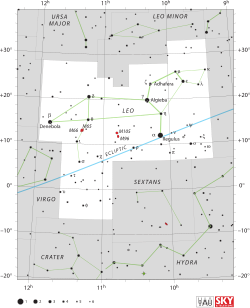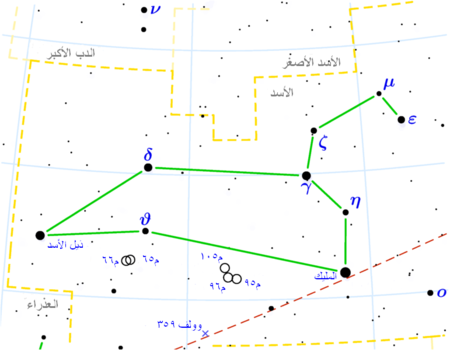ظهر الأسد أو "دلتا الأسد" واحد من ألمع نجوم كوكبة الأسد وهو يقع في أعلى مثلث النجوم الذي في يسار الكوكبة. نسبيا يعد ظهر الأسد نجما عاديا لكنه بالرغم من ذلك أكبر وأسخن من الشمس حيث تبلغ حرارته 8350 كلفن. وكتلته أكبر أيضاً حيث تساوي 2,2 كتلة شمسية. وهو متميز نسبيا بالقياسات الدقيقة التي أجريت لعمره وحجمه حيث سيتحول بعد 600 مليون سنة إلى عملاق برتقالي أو أحمر ثم سينكمش ويتحول إلى قزم أبيض. يبلغ القدر الظاهري لهذا النجم 2,56 أما القدر المطلق فهو 1,29، ويبعد عنا 57,5 سنة ضوئية تقريباً.
| ظهر الأسد | |
|---|---|
ظهر الأسد في كوكبة الأسد - الدائرة الحمراء( δ )
| |
| معلومات الرصد حقبة J2000 اعتدالان J2000 |
|
| كوكبة | الأسد |
| مطلع مستقيم | 11س 14د 06.50142ث[1] |
| الميل | ° 20 ′31 ″25.3853[1] |
| القدر الظاهري (V) | 2.56[2] |
| الخصائص | |
| نوع الطيف | A4 V[3] |
| U−B مؤشر اللون | +0.12[4] |
| B−V مؤشر اللون | +0.12[4] |
| نوع التغير | نجوم -دلتا- الدرع |
| القياسات الفلكية | |
| السرعة الشعاعية (Rv) | -20.2[2] كم/ث |
| الحركة الخاصة (μ) | +143.42[1]-129.88[1] |
| التزيح (π) | 55.82 ± 0.25 د.ق |
| البعد | 58٫4 ± 0٫3 س.ض (17٫91 ± 0٫08 ف.ف) |
| تفاصيل | |
| كتلة | 2.2[5] ك☉ |
| نصف قطر | 2.14 ± 0.040[6] نق☉ |
| ضياء | 15.5 ± 1.8[6] ض☉ |
| جاذبية سطحية (log g) | 3.91[7] سم.غ.ثا |
| درجة الحرارة | 8,296[6] ك |
| سرعة الدوران (v sin i) | 180[8] كم/ثا |
| عمر | 0.60-0.75[5] ج.سنة |
| تسميات اخرى | |
| Zosma, Zozma, Zosca, Duhr, Zubra,[9] تسمية باير, تسمية فلامستيد, مسح بون الفلكي +21°2298, فهرس النجوم الأساسية 422, فهرس بوس العام 15438, فهرس النجوم 2614.00, فهرس النجوم 419, فهرس هنري درابر 97603, هيباركوس 54872, فهرس النجم الساطع 4357, فهرس مرصد سميثسونيان للفيزياء الفلكية 81727.[10] | |
| قاعدة بيانات المراجع | |
| سيمباد | بيانات |
مراجع
- van Leeuwen, F. (November 2007), "Validation of the new Hipparcos reduction", Astronomy and Astrophysics, 474 (2): 653–664, arXiv:, Bibcode:2007A&A...474..653V, doi:10.1051/0004-6361:20078357
- Wielen, R.; et al. (1999), Sixth Catalogue of Fundamental Stars (FK6). Part I. Basic fundamental stars with direct solutions, Astronomisches Rechen-Institut Heidelberg, Bibcode:1999VeARI..35....1W
- Cowley, A.; et al. (April 1969), "A study of the bright A stars. I. A catalogue of spectral classifications", Astronomical Journal, 74: 375–406, Bibcode:1969AJ.....74..375C, doi:10.1086/110819
- Johnson, H. L.; et al. (1966), "UBVRIJKL photometry of the bright stars", Communications of the Lunar and Planetary Laboratory, 4 (99), Bibcode:1966CoLPL...4...99J
- Kaler, James B., ZOSMA (Delta Leonis), University of Illinois, مؤرشف من الأصل في 28 مارس 2020,12 مايو 2010
- Akeson, R. L.; et al. (February 2009), "Dust in the inner regions of debris disks around a stars", The Astrophysical Journal, 691 (2): 1896–1908, arXiv:, Bibcode:2009ApJ...691.1896A, doi:10.1088/0004-637X/691/2/1896
- Malagnini, M. L.; Morossi, C. (November 1990), "Accurate absolute luminosities, effective temperatures, radii, masses and surface gravities for a selected sample of field stars", Astronomy and Astrophysics Supplement Series, 85 (3): 1015–1019, Bibcode:1990A&AS...85.1015M
- Royer, F.; et al. (2002), "Rotational velocities of A-type stars in the northern hemisphere. II. Measurement of v sin i in the northern hemisphere", Astronomy and Astrophysics, 393 (3): 897–911, arXiv:, Bibcode:2002A&A...393..897R, doi:10.1051/0004-6361:20020943
- Allen, Richard Hinckley (1899), Star-names and their meanings, G. E. Stechert, صفحة 260, مؤرشف من الأصل في 14 يونيو 2019
- "del Leo -- Variable Star", SIMBAD, Centre de Données astronomiques de Strasbourg, مؤرشف من الأصل في 20 مارس 2016,12 مايو 2010


